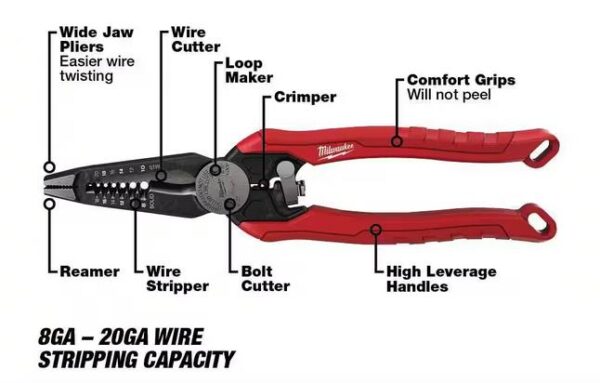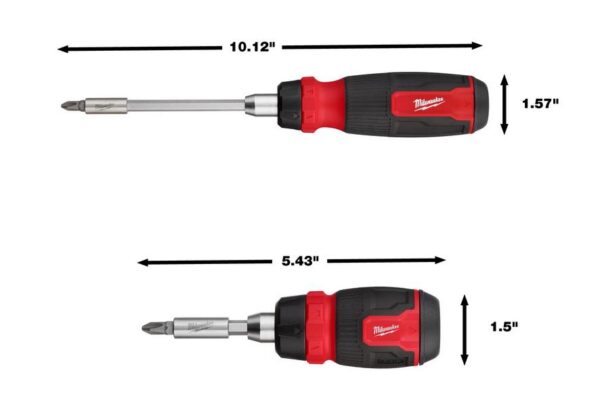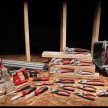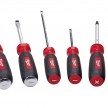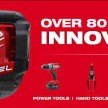Milwaukee Hand Tools
Milwaukee Combination Tools That Work
Combination tools as a category have an undeserved bad reputation, but the three Milwaukee Hand Tools we look at here are combination tools that work and have a loyal following.
Now, it’s true that many combination tools can be gimmicks – neither fish nor fowl at best, and worthless at worst. But remember that many of the common hand tools that we use every day are combination tools. To mention two easy examples: hammers both drive and pull nails, and lineman’s pliers grab, twist, pull, and cut wires (and some do even more).
The three Milwaukee combination tools here are types that have been around and used by pros for decades or more, so they have proven their merit.
Milwaukee 7-in-1 High Leverage Combination Pliers
The first of the Milwaukee combination tools that work is their 7-in-1 “combination” pliers (Model 48-22-3078). I put “combination” in quotes because while these pliers definitely combine seven functions, they aren’t what the industry usually thinks of as “combination” pliers (which are sort of smaller lineman’s pliers with an oval serrated hole for gripping nuts, bolts, etc., and are popular in Europe). Instead, these 7-in-1 pliers combine the gripping/twisting functions of lineman’s with the stripping functions of dedicated strippers, as well as 6/32 and 8/32 cutters, a crimper, and a looper. Indeed, this kind of combination electrical tool is now popular — Milwaukee came out with this particular version recently.

Basic Specs:
- Wide Jaw Pliers
- Crimper – Crimp Insulated and Non-Insulated Terminals
- Wire Stripper – Strips 8-18awg Solid and 10-20awg Stranded Wire
- Wire Cutter – Cuts up to four 12 AWG Wires
- Loop Maker
- Reamer – Ream 1/2″ – 1″ Conduit
- Bolt Cutter – Cut #6 and #8 Bolts
- High Leverage Handles
- Tether Ready Lanyard Hole
- $20 at The Home Depot
Judge a Tool by its Intended Use
I’ll start off by saying that the Milwaukee 7-in-1 High Leverage Combination Pliers do a great job given the job that they were designed to do, and that I use them a lot. I add that last bit because we have to evaluate any tool by the yardstick of the job it was intended to accomplish. Although they will strip up to 8 AWG wire, I think it’s safe to say that these pliers will see the most use in residential and commercial jobs running 14, 12, and maybe 10 AWG wiring in mind (although some electricians will undoubtedly find them a good match for other applications).
This Milwaukee combination tool will generally replace a set of lineman’s and a stripper. They reduce the number of tools that an electrician has to carry, which is important mostly if you are working in tight and/or remote spaces where carrying many tools is difficult. Think low, unfinished attics, or on top of a tower. But this isn’t the main reason that I prefer them over the tools they replace.
What a single wire manipulator/stripper does for me is provide continuity of workflow. To take romex (NM cable) as an example, I can use the jaws to rip the cable sheathing away, use the cutters to remove the stripped sheathing, strip the wires, pull them into a box, create loops in the wires, and twist together any wires that need twisting…all with the same tool that doesn’t leave my hand. No interrupting the workflow to switch up multiple tools.
Function by Function
So how well does the Milwaukee 7-in-1 High Leverage Combination Pliers perform its various functions? Well, remember that almost all combination tools require compromises in performance over dedicated tools. This one, as far as I can tell, is a compromise in only two areas. The jaw width is slightly narrower than regular lineman’s, and the jaws are further from the pivot meaning less leverage applied by them compared to regular lineman’s. However, bypass cutters are arguably more effective than traditional mating knives cutters!
Starting with the jaws, they are very aggressively (and precisely) knurled. This aggressive knurling lets them latch onto romex sheathing and tear it away with childish ease (see photo below). The jaws really shine here. These jaws are 7/16-inch wide in comparison to the usual 9/16- or even 5/8-inch width found on many dedicated lineman’s pliers. This means that these pliers will not easily twist as many strands of wire as wider-jawed pliers will, and this is the main compromise I see in this combination tool. However, this Milwaukee combination tool will easily twist four 14-gauge and two 12-gauge wires, and more with if you concentrate. Given that I regard it as a primarily residential/commercial, 120- and some 240-volt tool, this is just fine. If I’m working with 10-gauge or thicker wire I’ll want my regular lineman’s just for the added leverage.
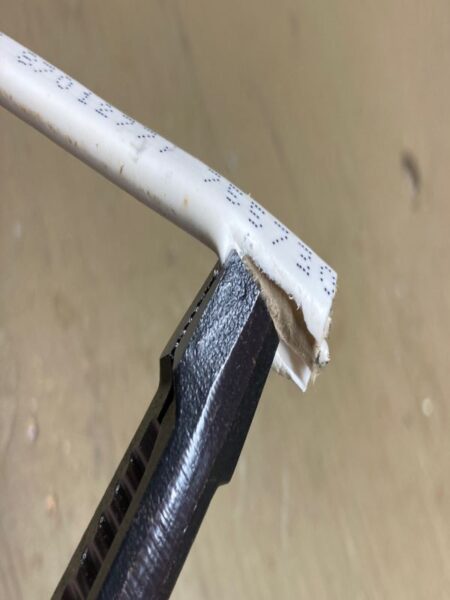
Even with the jaws’ greater distance from the pivot they still grab and twist wire nuts effectively (see photo below), but with a different feeling from regular lineman’s.
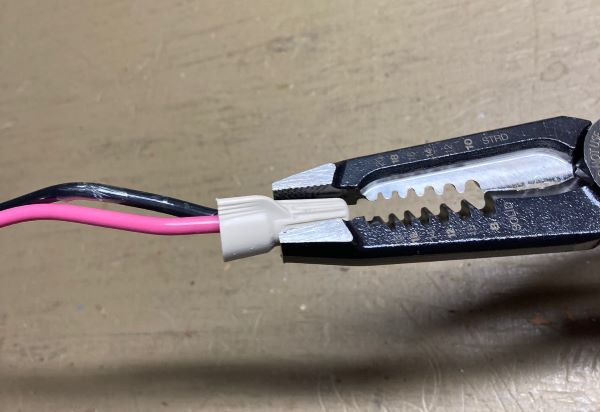
The strippers work flawlessly and easily. Nothing more to be said there.
The screw cutters are the usual type in which the screw is threaded into the cutter hole, the screw cut, and the screw backed out with the tool-steel threads of the pliers acting as a die to clean up the cut threads. This function works well and just as you’d expect with no surprises. The screw is cut where the two halves of the pliers mate, so it’s simple to judge the cut-off length. The looper and reaming functions are straightforward, also performing just as you’d expect
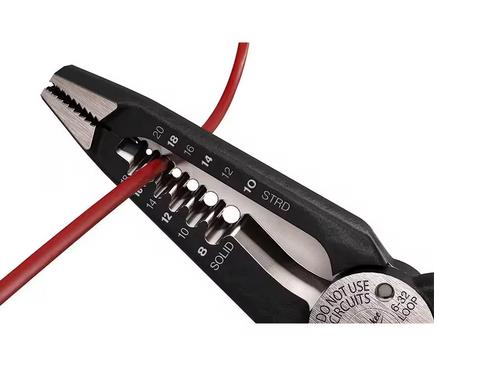
The crimper size isn’t specified, but it’s the “normal” size that I’ve seen on almost all linemans’ that incorporate one.
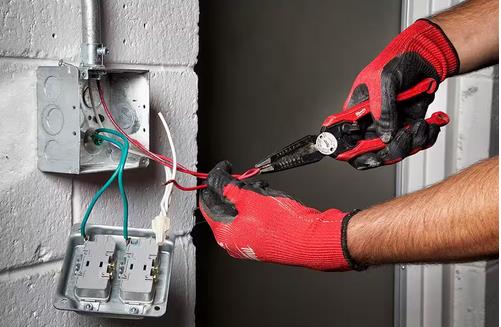
The cutter is a bypass design, in contrast to the mating knives style of most lineman’s pliers. The specs say it will cut four 12-gauge solid wires, which it will, but I had to use two hands (to be fair, my hands are somewhat arthritic these days). Cutting three 12-gauge wires, however, was easy with one hand. There are videos of these pliers cutting MC cable, but I doubt that that’s its intended use. (If you need to cut MC you’ll almost certainly know ahead of time and should have a proper cutter, although many tools can be pressed into service.) Still, if you’re in a pinch it’s nice to know that the Milwaukee 7-in-1 High Leverage Combination Pliers can do it.
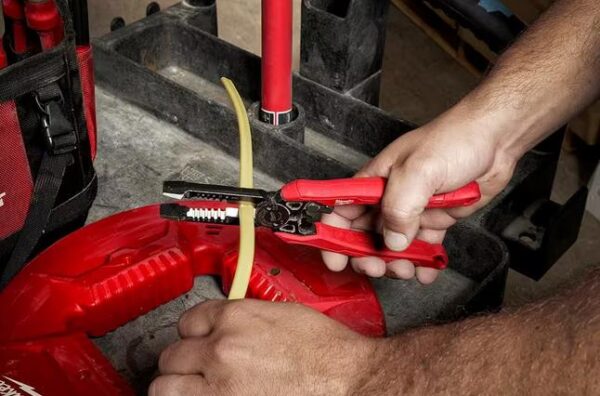
These pliers are “normally open”, and held that way with a spring. I’m pretty agnostic about this, but if you don’t like it you can easily remove the spring. Getting the spring back in place might be a challenge though, since it’s seated deeply into capturing holes on either handle. That deep spring capture, however, might mitigate the main functional disadvantage of a spring-loaded electrical tool, and that’s the fact that should it pop out unintentionally and drop into energized equipment, things might get a bit lively for a spell. However, many electrical tools are spring-loaded, so do what’s appropriate for the environment you work in.
I have average-size American male hands (which translates, somehow, to a size large glove), and the handles on these pliers are comfortable. Not too hard, not too soft. Not too wide, not too narrow. The lanyard holes aren’t squishy in your palm
Milwaukee Hand Tools | Bottom Line
There are over a million electricians in the United States alone. Naturally, they will vary in their preference for tools, and types of tools. But from observation and reading, a lot of them love combination pliers like these, which is why most of the mainstream electrical tools vendors make one. The Milwaukee 7-in-1 High Leverage Combination Pliers get high marks from many pros, and I’m also a fan. They won’t obsolete my lineman’s, but for many, if not most, of the 120-volt work that I do, particularly in remodeling, they are what I reach for these days.
Milwaukee 14 in 1 Ratcheting Multi-Bit Screwdriver
The second of the Milwaukee combination tools that work is their14 in 1 ratcheting multi-bit screwdriver (model 48-22-2905). This product comes bundled with an 8 in 1 compact version, but it’s the larger 14 in 1 unit that I’ll concentrate on here.
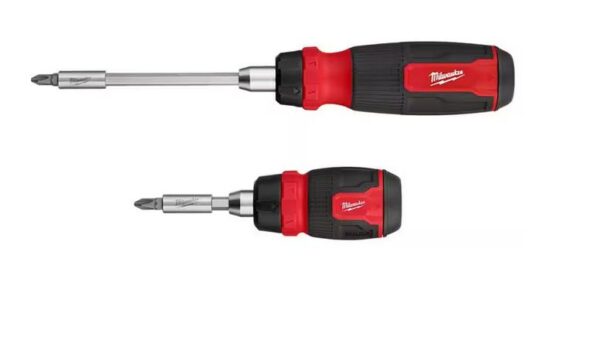
Now multi-bit screwdrivers are fairly common, and Milwaukee makes several models and styles. Typically multi-bit screwdrivers, from any vendor, incorporate double-ended bits, the better to pack multiple drivers into a shaft or handle. But I much prefer the style of this Milwaukee multi-bit screwdriver because it uses common, inexpensive, every day, single-bit insert bits. The product comes with 13 insert bits; add the ¼-inch hex nut driver that the insert bits mate with to get 14 drives.
Basic Specs:
- Easy access bits: in-handle bit storage
- Durable, all-metal ratchet: higher torque and faster driving
- Removable bit holder: power-tool ready with 1/4″ hex shank
- Removable bit holder: put bits directly in handle for access in tight spaces
- Wrench-ready hex shank for wrench-assisted turning
- Ergonomic handle with durable overmold
- Rare earth magnet: secures bit in bit holder
- Size ID on every bit
- Chrome-plated bit holder for rust protection
- Regular handle: P1, P2, SL 1/4″, SL 3/16″, SQ1, SQ2, SQ3, ECX1, ECX2, T10, T15, T20, T25 and 1/4″” nut driver Stubby handle: P1, P2, SL 3/16″, SL 1/4″, SQ1, SQ2, T15, and 1/4″ nut driver
- Limited Lifetime Warranty
- $35 at The Home Depot
Three Kinds of Multi-Bit Users
There are three kinds of tradespeople when it comes to multi-bit screwdrivers. One kind doesn’t use them at all. The second kind uses them almost all the time because they minimize the tool inventory that has to be carried. The third kind (and this is where I fall) uses regular screwdrivers for their most commonly encountered fasteners but has a multi-bit screwdriver in the tool bag stocked with drivers for all the unusual and infrequent drives that they do, or might, run into. It’s this perspective that I’m writing this review from.
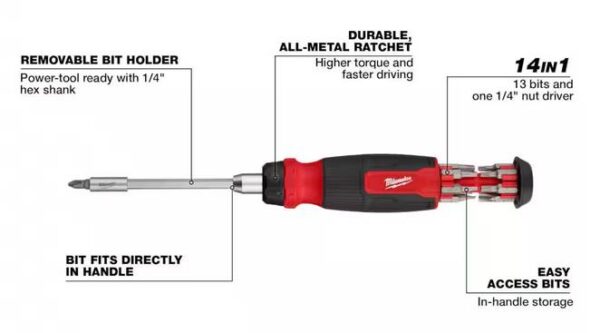
Trade-Offs
Most combination tools, including Milwaukee combination tools, and specifically this 14 in 1 screwdriver, involve trade-offs. On the plus side, multi-bit screwdrivers reduce the number of tools that you have to carry. On the minus side, they mean a considerably interrupted workflow when you change bits. For my use of them – availability of unusual or seldom-encountered drives – this is a good trade-off.
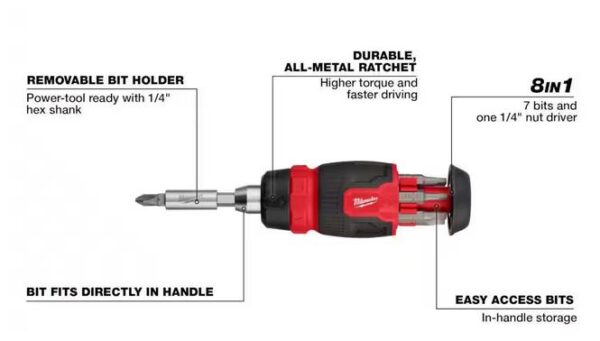
Features and Benefits
A multi-bit screwdriver will be a familiar tool to our readers, so I won’t address the obvious. Let me just mention the features that make this Milwaukee version of it my favorite of this type on the market.
The use of common insert bits means that I can inexpensively custom-assemble a bit collection that matches the unusual drives that I might encounter. This Milwaukee 14 in 1 screwdriver comes standard with two ECX bits for use in electrical fixtures, a drive that I find quite useful.
This Milwaukee multi-bit screwdriver stores its collection of bits in a manner that makes retrieving them easy with your fingers. This is only worth mentioning because some of Milwaukee’s competitors’ multi-bit screwdrivers, which also use insert bits, store those bits in the handle in such a way that you need to use a tool of some sort to pry them out.
The ratcheting mechanism has distinct and positive stops at clockwise, counter-clockwise, and locked-out. I tend to lock the ratcheting out, and with this screwdriver I don’t have to worry about it engaging by mistake.
The hard plastic/over-molded handle is comfortable to use, even as the handle is larger than most regular screwdrivers’ handles are, in order to store the bits. (All multi-bit screwdrivers have large handles for this reason.)
The longer 3.75-inch shank of the 14 in 1 screwdriver and the 1.5-inch shank of its sister 8 in 1 tool can be interchanged, giving you the choice of two shaft lengths.
These two multi-bit screwdrivers do have one disconcerting characteristic though: the shaft wobbles a little where it inserts to the handle. But this doesn’t affect the feel or performance of the tool when driving fasteners, even though you think it would.
Milwaukee 13 in 1 Cushion Grip Screwdriver
The third of the Milwaukee combination tools that work is the 13 in 1 Cushion Grip Screwdriver (model 438-22-2280)
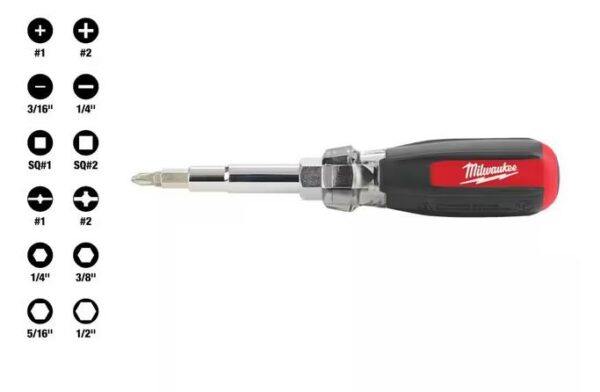
Basic Specs:
- 13 functions
- Tri-Material Cushion Grip Handle
- Limited Lifetime Warranty
- 8 driver bits – P1, P2, SL 3/16″, SL ¼”, SQ1, SQ2, ECX1, ECX2
- 4 nut drivers – ¼”, 5/16”, 3/8”, 1/2”
- Loop maker
- $19 at The Home Depot
This is a more traditional combination screwdriver, incorporating four different nut drives. The bits are, as usual, double-ended. We’re all familiar with this style of combination screwdriver, so let me just tell you what I think makes this a really good example of the kind.
The first thing you notice when you pick it up is just how solid it feels… how well-balanced…and how comfortable it is. This tool just feels good in your hand.
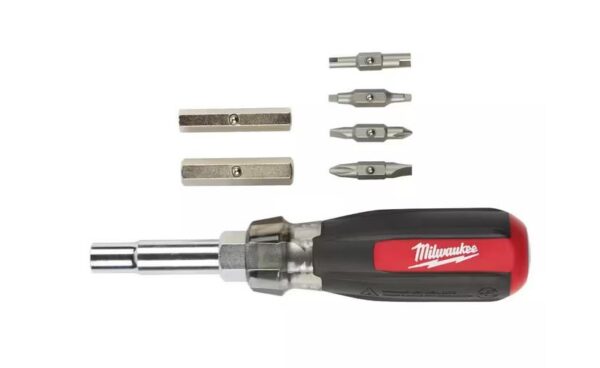
The components are all solid too. Everything fits together tightly. The handle feels good as you use it to turn fasteners; you can bear down and generate some torque, yet it also spins easily for low-torque turning.
It comes with two ECX drives, which I find useful.
The only modification I’ll make to this combination screwdriver is to add a mark on the hex-shaped bolster to let me know where the spline on the barrel is inserted.
All in all, this Milwaukee 13 in 1 Cushion Grip Screwdriver is a strong contender for “best in class” when it comes to this style tool. This is a time-tested combination tool that works. Many electricians (the trade with which I’m most familiar) swear that they can get 90% of their job done with this combination screwdriver and the Milwaukee 7 in 1 combination pliers described above. Certainly, for residential maintenance and remodeling, that’s probably no exaggeration.
And it’s not just tradespeople who can benefit from combination tools. Imagine a rancher riding a horse out to a piece of field equipment that needs work. Weight and volume are at a premium here.
Some Combination Tools Work
Some combination tools work, and some don’t. As with most reviews, I can’t tell you how long they’ll last, but I can tell you that these three Milwaukee Hand Tool combination do work.



